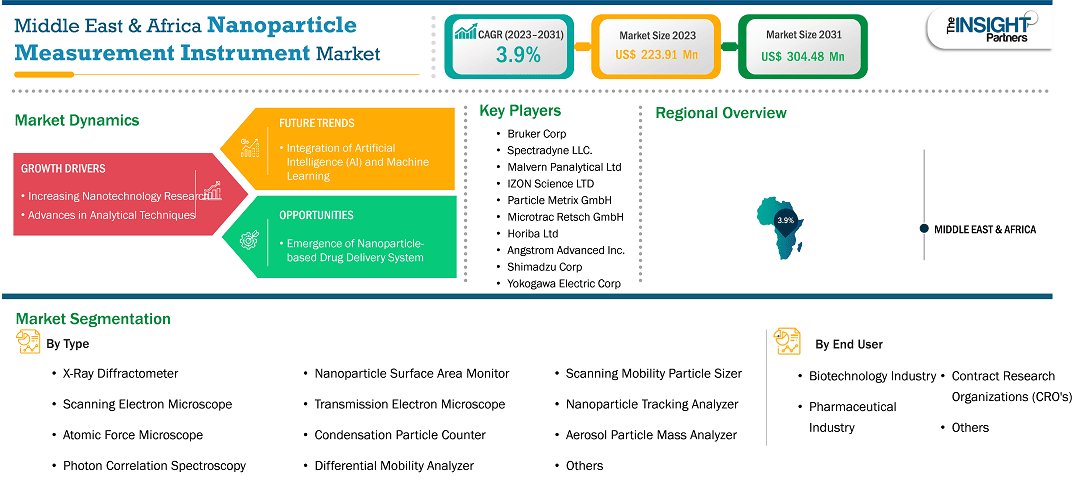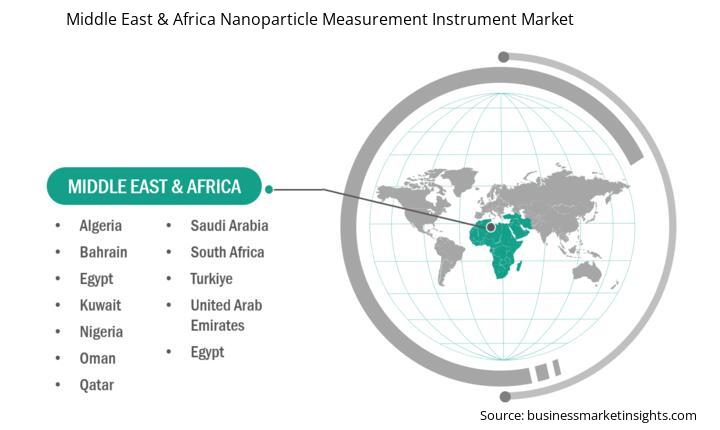Marktbericht für Nanopartikelmessgeräte im Nahen Osten und Afrika (2021-2031) nach Umfang, Segmentierung, Dynamik und Wettbewerbsanalyse
No. of Pages: 136 | Report Code: TIPRE00028776 | Category: Life Sciences
No. of Pages: 136 | Report Code: TIPRE00028776 | Category: Life Sciences
Der Markt für Nanopartikelmessgeräte im Nahen Osten und Afrika wird voraussichtlich von 223,91 Millionen US-Dollar im Jahr 2023 auf 304,48 Millionen US-Dollar im Jahr 2031 anwachsen. Von 2023 bis 2031 wird für den Markt eine durchschnittliche jährliche Wachstumsrate (CAGR) von 3,9 % erwartet.
Der Markt für Nanopartikelmessgeräte im Nahen Osten und Afrika ist in Saudi-Arabien, Südafrika, die Vereinigten Arabischen Emirate und den Rest des Nahen Ostens und Afrikas unterteilt. Südafrika hatte im Jahr 2023 den größten Marktanteil bei Nanopartikelmessgeräten. Faktoren wie die Einführung der Nanotechnologie im Gesundheitswesen, die Entwicklung von Goldnanopartikeln und die Präsenz von Marktteilnehmern tragen zum Wachstum des Marktes für Nanopartikelmessgeräte im Nahen Osten und Afrika bei .

Schlüsselsegmente, die zur Ableitung der Marktanalyse für Nanopartikelmessgeräte im Nahen Osten und Afrika beigetragen haben , sind Typ und Endbenutzer.
Nanotechnologie wird in immer mehr Anwendungen der Pharmaindustrie eingesetzt, darunter in der Krebsbehandlung, der gezielten Arzneimittelverabreichung und der diagnostischen Bildgebung. Der Einsatz von Nanopartikeln als Trägersubstanzen für Arzneimittel trägt dazu bei, die Wirksamkeit therapeutischer Kandidaten zu erhöhen und ihre Nebenwirkungen zu verringern. Nanopharmazeutika sind Materialien, die im Nanomaßstab manipuliert werden, oft um Arzneimittel mit verbesserter Bioverfügbarkeit, kontrollierter Freisetzung oder gezielter Zielausrichtung herzustellen. Diese Anwendungen erfordern präzise Messgeräte zur Überwachung der Arzneimittelverabreichung, zur Gewährleistung der Qualitätskontrolle und zur Charakterisierung der Nanopartikel. Die Entwicklung von Nanopharmazeutika setzt ein gründliches Verständnis und die Kontrolle über Größe, Form, Oberflächenladung und Zusammensetzung von Nanopartikeln voraus. Daher sind Zetapotenzialanalysatoren, Elektronenmikroskope und Größenanalysatoren für Untersuchungen im Zusammenhang mit Nanopartikeln unverzichtbar. Die laufende Forschung in der Nanotechnologie führt somit zu einem Bedarf an immer ausgefeilteren und präziseren Messinstrumenten. Nanopharmazeutika können die präzise Abgabe von Arzneimitteln an bestimmte Gewebe oder Zellen sicherstellen und gleichzeitig deren Stabilität und Löslichkeit verbessern. Die kontinuierlichen Forschungs- und Optimierungsbemühungen im Bereich der Nanotechnologie hängen von der Verfügbarkeit hochentwickelter Messinstrumente ab, um die Wechselwirkungen und Eigenschaften im Nanomaßstab zu verstehen und zu verändern.
Der Innovationsdrang im Pharmasektor durch Nanotechnologie erhöht den Bedarf an hochentwickelten Messinstrumenten für Nanopharmazeutika. Diese Instrumente sind für die Entwicklung, Charakterisierung und Qualitätssicherung von Nanopharmazeutika von entscheidender Bedeutung und gewährleisten die Einhaltung strenger Sicherheits-, Wirksamkeits- und regulatorischer Vorgaben .
Der Markt für Nanopartikelmessgeräte im Nahen Osten und Afrika umfasst nach Ländern Südafrika, Saudi-Arabien, die Vereinigten Arabischen Emirate und den Rest des Nahen Ostens und Afrikas. Südafrika hatte im Jahr 2023 den größten Anteil.
Im Februar 2020 organisierten die South African Agency for Science and Technology Advancement (SAASTA) und das Nanotechnology Public Engagement Programme (NPEP) in Zusammenarbeit mit dem Department of Science and Innovation (DSI) ein Nanotechnologie-Symposium. Das Symposium soll eine Plattform für Diskussionen über Sicherheit und Umwelt der Nanotechnologie bieten und so die nachhaltige Entwicklung der Nanotechnologie im Land fördern.
Die Pharma- und Biotechnologiebranche in Südafrika hat durch den Einsatz von Nanotechnologie im Gesundheitswesen Fortschritte erzielt. Gemäß den von den UN-Mitgliedsstaaten vorgeschlagenen Zielen für nachhaltige Entwicklung (SDGs) kann die Einführung von Nanotechnologie in Südafrika potenzielle Therapien zur Vorbeugung chronischer Krankheiten wie Tuberkulose und Malaria sowie zur Bekämpfung von AIDS, Hepatitis sowie durch Wasser übertragbaren und anderen Infektionskrankheiten hervorbringen. In Südafrika wurden in den vergangenen Jahren Nanomaterialien wie Gold- und Silbernanopartikel, Kohlenstoffnanoröhren und Quantenpunkte eingesetzt, um Viren wie SARS-CoV-2 schnell zu diagnostizieren und Krebs frühzeitig zu erkennen. So produzierten Wissenschaftler von Afrigen Biologics in Kapstadt im Jahr 2022 erfolgreich eine Laborcharge eines COVID-19-Impfstoffs, der dem von Moderna ähnelt. Dieser Erfolg bietet Ländern mit niedrigem und mittlerem Einkommen die Möglichkeit, ihre eigenen Impfstoffe herzustellen. Darüber hinaus haben südafrikanische Forschungseinrichtungen wie der Council for Scientific and Industrial Research (CSIR) und private Unternehmen nanotechnologiebasierte Prototypen zur Wasserreinigung und -aufbereitung entwickelt. Daher wird erwartet, dass die Einführung nanopartikelbasierter Therapien, wie beispielsweise Impfstoffe auf Goldnanopartikelbasis, den Marktteilnehmern von Nanopartikelmessinstrumenten im Prognosezeitraum die Möglichkeit bietet, ihren Kundenstamm landesweit zu erweitern.
| Berichtsattribut | Details |
|---|---|
| Marktgröße im Jahr 2023 | 223,91 Millionen US-Dollar |
| Marktgröße bis 2031 | 304,48 Millionen US-Dollar |
| Globale CAGR (2023 – 2031) | 3,9 % |
| Historische Daten | 2021-2022 |
| Prognosezeitraum | 2024–2031 |
| Abgedeckte Segmente | Nach Typ
|
| Abgedeckte Regionen und Länder | Naher Osten und Afrika
|
| Marktführer und wichtige Unternehmensprofile |
|
Zu den wichtigsten Akteuren auf dem Markt zählen unter anderem Bruker, Spectradyne LLC., Malvern Panalytical Ltd., IZON Science LTD., Particle Metrix GmbH, Microtrac Retsch GmbH, Horiba Ltd., Angstrom Advanced Inc., Shimadzu Corp. und Yokogawa Electric Corp. Diese Akteure verfolgen verschiedene Strategien wie Expansion, Produktinnovation sowie Fusionen und Übernahmen, um ihren Kunden innovative Produkte anzubieten und ihren Marktanteil zu vergrößern.
Für die Erhebung und Analyse der in diesem Bericht dargestellten Daten wurde die folgende Methodik angewendet:
Der Forschungsprozess beginnt mit einer umfassenden Sekundärforschung. Dabei werden sowohl interne als auch externe Quellen genutzt, um qualitative und quantitative Daten für jeden Markt zu sammeln. Zu den häufig zitierten Sekundärforschungsquellen gehören unter anderem:
Hinweis: Alle Finanzdaten im Abschnitt „Unternehmensprofile“ wurden auf US-Dollar standardisiert. Für Unternehmen, die in anderen Währungen berichten, wurden die Zahlen anhand der entsprechenden Wechselkurse des entsprechenden Jahres in US-Dollar umgerechnet.
Business Market Insights führt jedes Jahr eine beträchtliche Anzahl von Primärinterviews mit Branchenvertretern und Experten durch, um seine Datenanalyse zu validieren und wertvolle Erkenntnisse zu gewinnen. Diese Forschungsinterviews dienen dazu:
Die Primärforschung erfolgt per E-Mail und Telefoninterviews und umfasst verschiedene Märkte, Kategorien, Segmente und Untersegmente in unterschiedlichen Regionen. Zu den Teilnehmern gehören typischerweise:

Der Markt für Nanopartikelmessgeräte im Nahen Osten und Afrika wird im Jahr 2023 auf 223,91 Millionen US-Dollar geschätzt und soll bis 2031 304,48 Millionen US-Dollar erreichen.
Laut unserem Bericht „Markt für Nanopartikel-Messgeräte im Nahen Osten und Afrika“ wird das Marktvolumen im Jahr 2023 auf 223,91 Millionen US-Dollar geschätzt und soll bis 2031 304,48 Millionen US-Dollar erreichen. Dies entspricht einer durchschnittlichen jährlichen Wachstumsrate (CAGR) von etwa 3,9 % im Prognosezeitraum.
Der Marktbericht für Nanopartikelmessgeräte im Nahen Osten und Afrika deckt in der Regel diese Schlüsselsegmente ab:
Der historische Zeitraum, das Basisjahr und der Prognosezeitraum können je nach Marktforschungsbericht leicht variieren. Für den Marktbericht für Nanopartikelmessgeräte im Nahen Osten und Afrika gilt jedoch Folgendes:
Historischer Zeitraum: 2021–2022Basisjahr: 2023Prognosezeitraum: 2024–2031Der Markt für Nanopartikelmessgeräte im Nahen Osten und Afrika ist von mehreren wichtigen Akteuren geprägt, die jeweils zu Wachstum und Innovation beitragen. Zu den wichtigsten Akteuren gehören:
BrukerSpectradyne LLC.Malvern Panalytical LtdIZON Science LTDParticle Metrix GmbHMicrotrac Retsch GmbHHoriba LtdAngstrom Advanced Inc.Shimadzu CorpYokogawa Electric CorpDer Marktbericht für Nanopartikelmessgeräte im Nahen Osten und Afrika ist für verschiedene Interessengruppen wertvoll, darunter:
Grundsätzlich kann jeder, der an der Wertschöpfungskette des Marktes für Nanopartikelmessgeräte im Nahen Osten und Afrika beteiligt ist oder eine Beteiligung daran in Erwägung zieht, von den Informationen eines umfassenden Marktberichts profitieren.